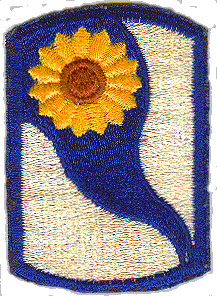

The 69th Infantry Brigade (Separate) was organized on 1 April 1963 in the National Guard of Kansas, with its Headquarters located at Topeka, Kansas.
Major General Charles H. Browne, Jr., former commander of the 35th Infantry Division, was in charge of the Brigade with the rank of Brigadier General.The 69th Infantry Brigade was composed of:
- Headquarters and Headquarters Company, 69th Brigade
- 1st Battalion, 137th Infantry
- 2nd Battalion, 137th InfantryThe Brigade was reorganized on 14 February 1964 as follow:
- Headquarters and Headquarters Company, 69th Brigade
- 1st Battalion, 137th Infantry
- 2nd Battalion, 137th Infantry
- 2nd Battalion, 130th Artillery
- E Troop, 114th Cavalry
- 169th Engineer Company
- 169th Support Battalion"The mission of the 69th was to provide, in accordance with the Department of the Army's Mobilization Program (MTP), units with strength, state of training, and equipment sufficient to enable them to be deployed with the minimum of post mobilization training time."
On October 1, 1965, Colonel John W. Breidenthal took over the Brigade. Breidenthal was the Deputy Commander of the Brigade and was replaced by LTC Thomas J. Kennedy. Breidenthal was promoted BG, and Kennedy, COL.
On October 15, The 69th Infantry Brigade became part of the Selected Reserve Force (SRF). "The Selected Reserve Force was formed to take its place in the nation's strategic manpower reserve as a principal striking force for any contingency that might develop. It provided a strategic ready reserve capable of deploying and achieving a state of combar readiness in a minimum of time."
To meet the requirements of the SRF program, the Brigade was reorganized.
Organization of late 1965:- Headquarters and Headquarters Company, 69th Brigade
- 1st Battalion, 137th Infantry
- 2nd Battalion, 137th Infantry
- 1st Battalion, 138th Infantry
- 2nd Battalion, 130th Artillery
- E Troop, 114th Cavalry
- 169th Aviation Company
- 169th Engineer Company
- 169th Support Battalion"Units of the 69th increased their strength to 100% of their authorized war-time quota, and realized a higher equipment level than at any previous time in the peace-time history of the Kansas National Guard."
In June 1967, the Brigade conducted field training at Fort Riley, KS. The 1st Bn, 63rd Armor, equipped with the new M551 Sheridan tank, was attached to the 69th. Troop E, 114th Cav was issued M48 tanks for the field training.
On December 15, 1967, the 3rd Battalion, 137th Infantry was assigned to the 69th Infantry Brigade.
"On April 11, 1968, a Presidential Order mustered 12,800 army guardsmen from 17 states into Federal Service. Among those called were the men of the 69th Infantry Brigade. All major commands of the 69th were Kansas based except the 2nd Battalion, 133rd Infantry, a mechanized infantry battalion attached to the 69th at the time of activation. The Iowa unit was based in Sioux City with subordinate units at LeMars Sheldon, Ida Grove, Cherokee, and Mapleton."
The 241st Military Intelligence Detachment, an Army Reserve unit from Boston, MA, was attached to the Brigade. The 3rd Battalion, 137th Infantry was left to the disposal of the Governor of Kansas.
The 69th Infantry Brigade was ordered to active duty effective 13 May 1968.
" General Breidenthal and his staff co-ordinating immediately with the Department of the Army in preparation for mobilization. Much had to be accomplished prior to the scheduled movement to Fort Campbell, KY. But, on 17 April 1968, a change of destination was announced by the Department of the Army. Now, the 69th was to be sent to Fort Carson, Colorado."
"Later in the month, Colonel Kennedy, Deputy Brigade Commander, and a select staff of officers traveled to Fort Carson to establish liaison with post officials for the arrival of the unit in May.""At 0600 hours, 13 May 1968, all personnel reported to their respective armories. As packing began, light organizational equipment was loaded into Brigade's vehicles in preparation for the departure of the advance party on 17 May 1968 for Fort Carson, home of the RED DEVILS of the 5th Infantry Division (Mechanized). Heavy equipment was prepared for movement by rail."